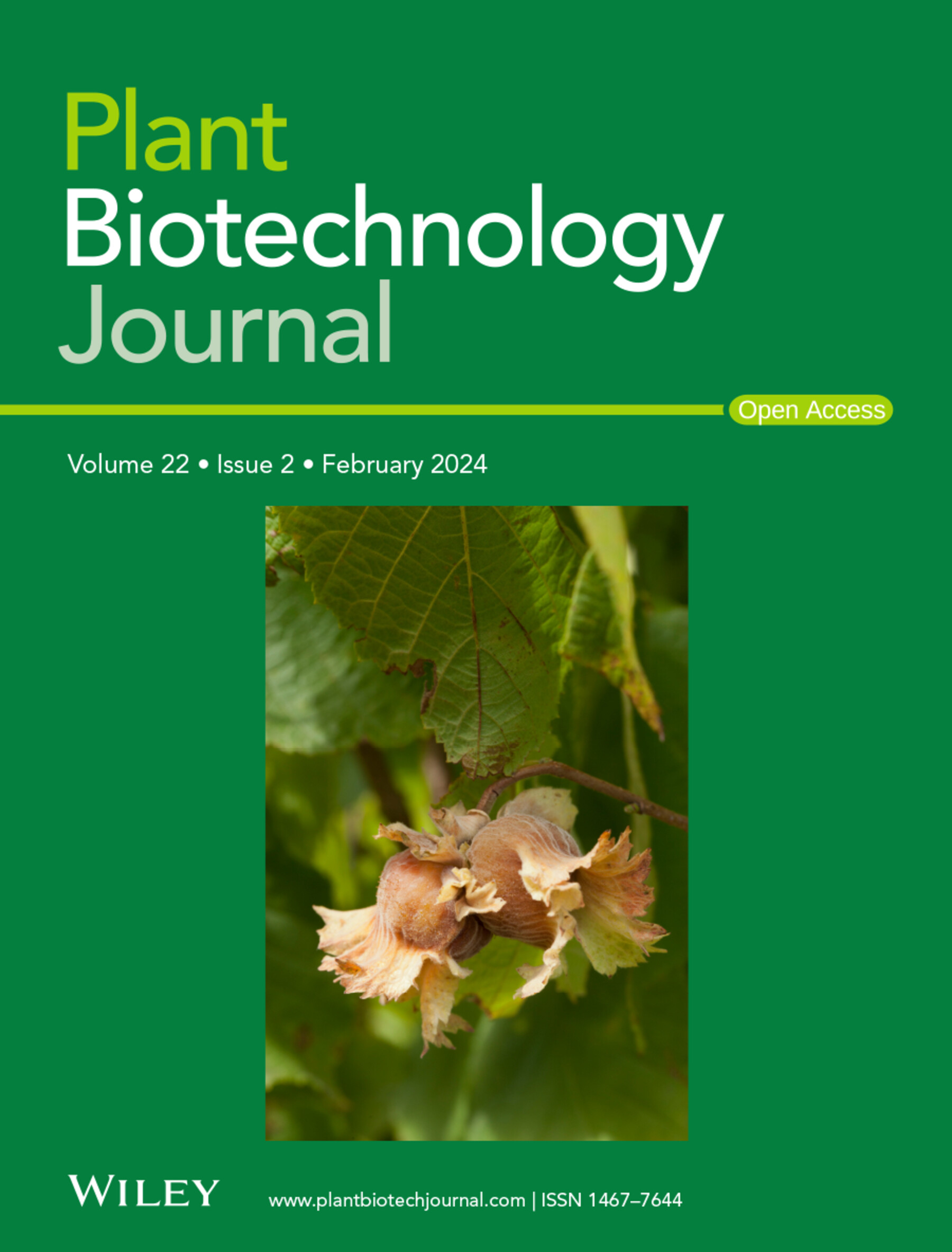苜蓿转录因子MsNAC2a通过活性氧积累和硫化氢消耗协调盐胁迫响应的稳态。
IF 10.5
1区 生物学
Q1 BIOTECHNOLOGY & APPLIED MICROBIOLOGY
引用次数: 0
摘要
土壤盐碱化对紫花苜蓿的生长发育构成严重威胁,限制了其生产力,阻碍了其广泛种植。硫化氢(H2S)在植物中是一种重要的气体信号分子,介导了许多生理过程,如耐盐性。然而,盐碱胁迫下紫花苜蓿H2S积累及其调控的分子机制尚不完全清楚。在本研究中,我们证明了NAC转录因子MsNAC2a是紫花苜蓿抗盐胁迫的负调节因子。MsNAC2a的组成性过表达下调l -半胱氨酸DESULFHYDRASE1 (MsLCD1)等H2S生物合成相关基因的表达,上调参与H2S代谢的关键基因O-ACETYLSERINE(THIOL)LYASE ISOFORM A1 (MsOASA1)基因的表达,同时抑制MsCOX11等活性氧(ROS)清除基因的表达,导致硫化氢水平降低,ROS积累增加,最终损害植物的耐盐性。此外,AP2/ erebp型转录因子MsEREBP1在体内和体外均与MsNAC2a发生物理相互作用,影响其转录活性并调节苜蓿的盐胁迫反应。相反,沉默MsNAC2a增强了植物的耐盐性,而不影响植物的生长或产量。综上所述,我们的研究强调了MsNAC2a精确调控盐胁迫响应的内稳态,并为MsNAC2a和MsEREBP1之间的协同相互作用微调内源H2S水平的机制提供了新的见解,从而影响苜蓿的耐盐性,为提高作物在盐胁迫下的抗逆性提供了有价值的策略。本文章由计算机程序翻译,如有差异,请以英文原文为准。
Alfalfa Transcription Factor MsNAC2a Orchestrates the Homeostasis of Salt Stress Responses via Reactive Oxygen Species Accumulation and Hydrogen Sulphide Depletion.
Soil salinisation poses a significant threat to alfalfa (Medicago sativa L.) growth and development, limiting its productivity and hindering its widespread cultivation. Hydrogen sulphide (H2S) serves as an important gaseous signalling molecule in plants, mediating a myriad of physiological processes like salt tolerance. However, the molecular mechanisms underlying H2S accumulation and its regulation under salinity stress in alfalfa are still not fully elucidated. In this study, we demonstrated that MsNAC2a, a NAC transcription factor, is a negative modulator of salt stress resistance in alfalfa. Constitutive overexpression of MsNAC2a downregulated the expression of H2S biosynthesis-related genes, such as L-CYSTEINE DESULFHYDRASE1 (MsLCD1), and upregulated the O-ACETYLSERINE(THIOL)LYASE ISOFORM A1 (MsOASA1) gene, a key gene involved in H2S metabolism, while also suppressing the expression of reactive oxygen species (ROS) scavenging genes like MsCOX11, leading to a reduction in hydrogen sulphide levels and an increase in ROS accumulation, ultimately impairing the plant's salt tolerance. Furthermore, the AP2/EREBP-type transcription factor MsEREBP1 physically interacts with MsNAC2a both in vivo and in vitro, influencing its transcriptional activity and modulating salt stress responses in alfalfa. Conversely, silencing MsNAC2a enhanced salt stress resistance without affecting plant growth or yield. Collectively, our study highlights that MsNAC2a precisely regulates the homeostasis of salt stress responses and provides new insights into the mechanisms by which the cooperative interaction between MsNAC2a and MsEREBP1 fine-tunes the homeostasis of endogenous H2S levels, thereby influencing alfalfa's salt tolerance and offering valuable strategies for improving crop resilience under saline stress.
求助全文
通过发布文献求助,成功后即可免费获取论文全文。
去求助
来源期刊

Plant Biotechnology Journal
生物-生物工程与应用微生物
CiteScore
20.50
自引率
2.90%
发文量
201
审稿时长
1 months
期刊介绍:
Plant Biotechnology Journal aspires to publish original research and insightful reviews of high impact, authored by prominent researchers in applied plant science. The journal places a special emphasis on molecular plant sciences and their practical applications through plant biotechnology. Our goal is to establish a platform for showcasing significant advances in the field, encompassing curiosity-driven studies with potential applications, strategic research in plant biotechnology, scientific analysis of crucial issues for the beneficial utilization of plant sciences, and assessments of the performance of plant biotechnology products in practical applications.
 求助内容:
求助内容: 应助结果提醒方式:
应助结果提醒方式:


